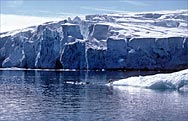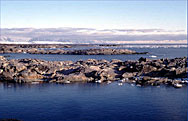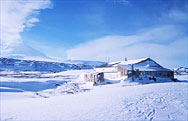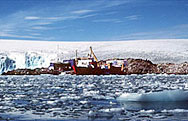 |
Overview
| A team of seven scientists lead by UAB biologists James McClintock, Ph.D., and Charles Amsler, Ph.D., and by chemist Bill Baker, Ph.D., from the Florida Institute of Technology landed at Palmer Station, Antarctica, March 2, where they spent almost three months diving beneath the coldest waters on earth investigating the survival secrets of a kaleidoscopic array of marine life. The mission to Palmer Station, funded by the Office of Polar Programs at the National Science Foundation, continues research pursued by McClintock, Baker and, most recently, Amsler, whose expeditions and discoveries have been publicized in American Scientist, Nature, and the Wall Street Journal.
“We are looking at the chemical defenses of marine organisms as well as plants, and endeavoring to understand exactly how they use these chemicals to defend themselves -- how they wage chemical warfare if you will,” said McClintock, dean of the UAB School of Natural Sciences and Mathematics. “This will allow scientists to understand the ecological structure of Antarctic marine life.”
“The work,” Amsler adds, “will be important not only to understanding marine life in Antarctica but, more significantly, to marine and terrestrial organisms all over the world." Palmer Station sits on a protected harbor on the southwestern coast of Anvers Island off the Antarctica Peninsula. Palmer is the only U.S. Antarctic station north of the Antarctic Circle. The temperature is mild, with monthly averages ranging from minus 10 degrees Celsius in July and August to 2 degrees Celsius in January and February.
The station, built on solid rock, consists of two major buildings and three small ones, plus two large fuel tanks, a helicopter pad, and a dock. Construction was completed in 1968, replacing a prefabricated wood structure ("Old Palmer,'' established in 1965) two kilometers away across Arthur Harbor.
About 40 people can occupy Palmer in the summer. The wintering population is about 10, although Palmer does not have a long period of winter isolation as does McMurdo Station. McMurdo, about 1,000 kilometers due south, is the largest research station in Antarctic, providing facilities for as many as 1,000 people.
During expeditions to Antarctica in recent years, the group of biologists and chemists set up remote field camps in Explorers Cove on Ross Sea, an area on Scott Coast, Victoria Land, about 50 miles northwest of McMurdo Station.
“We typically would set up a long-term field camp at this site, dynamite holes in the sea ice and dive 100 to 130 feet to the bottom to collect our study organisms,” McClintock said. “Biologists have conducted studies of the ecology and physiology of a number of marine animals from this vicinity. It is a somewhat unique sea bottom, not unlike communities that occur in the deep sea. [Here] marine biologists can study the deep sea in relatively shallow water.”
During these dives, scientists study predator defenses in a variety of marine sponges, echinoderms and nudibranchs plus the chemical interactions between invertebrates and their bacterial and algal microfloras. Although the project’s aim is to understand their ecological functions, the toxic defense compounds of the invertebrates could one day play a role in the prevention of diseases like cancer and AIDS, McClintock said.
At Palmer Station on the Antarctic Peninsula macroalgae and invertebrate larvae are much more common than at McMurdo Sound. Therefore the researchers will be able to expand their chemical studies to new types and new life history stages of Anarctic marine organizems. And, researchers will be able to readily access the sea from small boats without having to blow holes in the ice. They will have to be vigilant in spotting and keeping away from dangerous leopard seals, which are common in these waters. “The sea bottom near Palmer is dominated by macroalgae, McClintock said. “There are almost no macroalgae at McMurdo, where I've been working recently. This coupled with some of the unique oceanographic characteristics of coastal Antarctica allow us to pose important new scientific questions that could not be examined anywhere else, including at McMurdo. Questions such as how the availability of certain nutrients in the sea water influence growth and the allocation of chemical defenses in marine plants.”
Joining McClintock, Amsler and Baker on the expedition are UAB graduate student Andrew Mahon, B.S. M.A; UAB post-doctoral student Katrin Iken, Ph.D.; Joanna Hubbard, a teacher at Hanshew Middle School in Anchorage, Alaska; and Bruce Furrow, B.S., MA, a graduate student from Florida Institute of Technology.
|
 |
|





